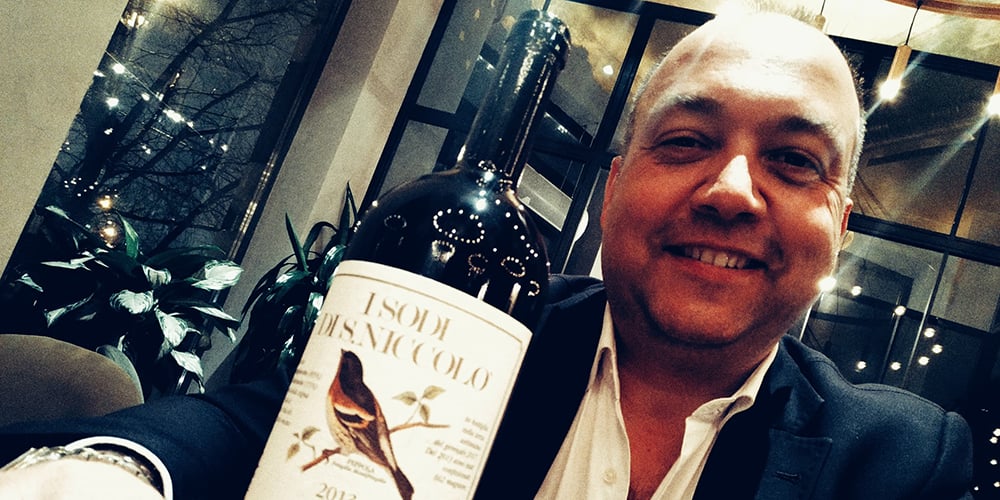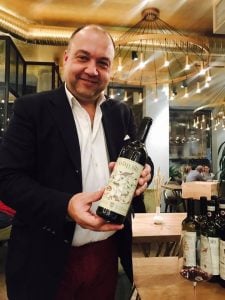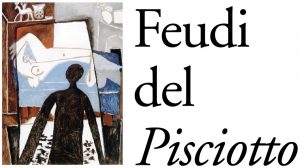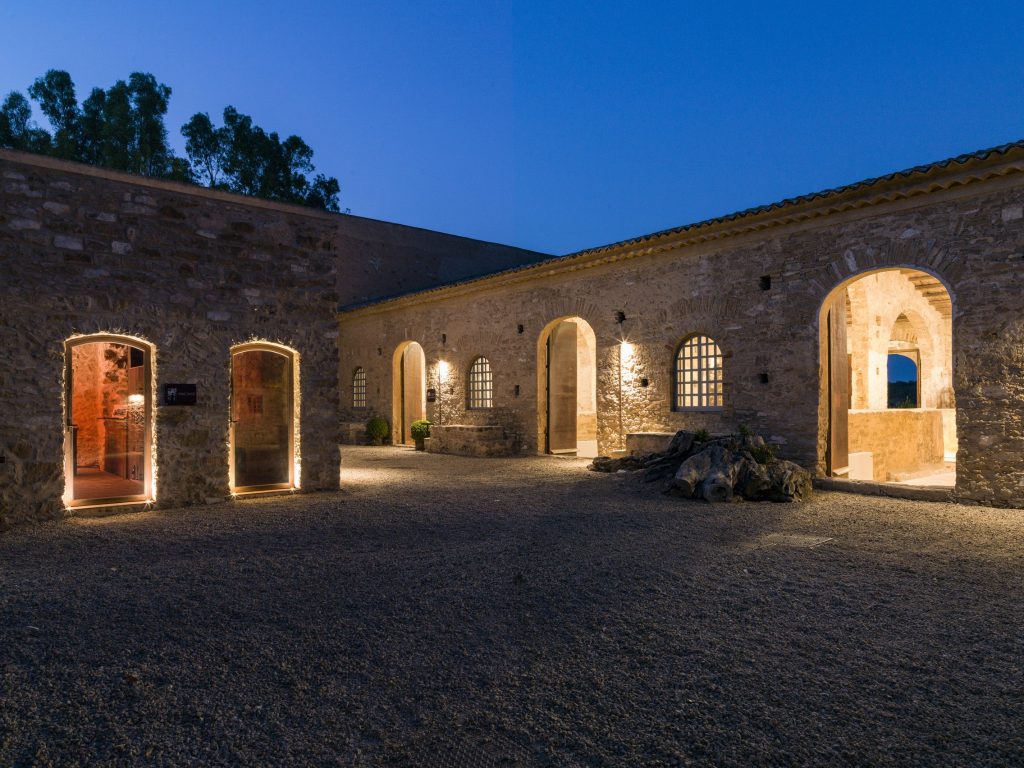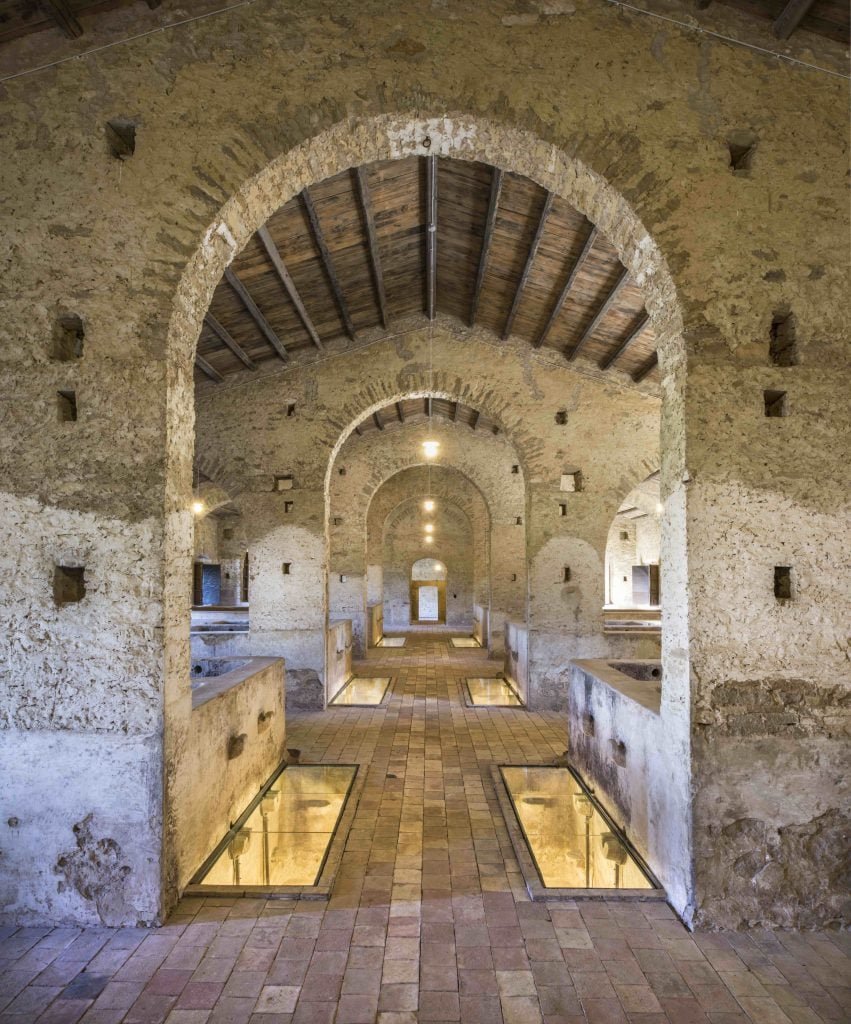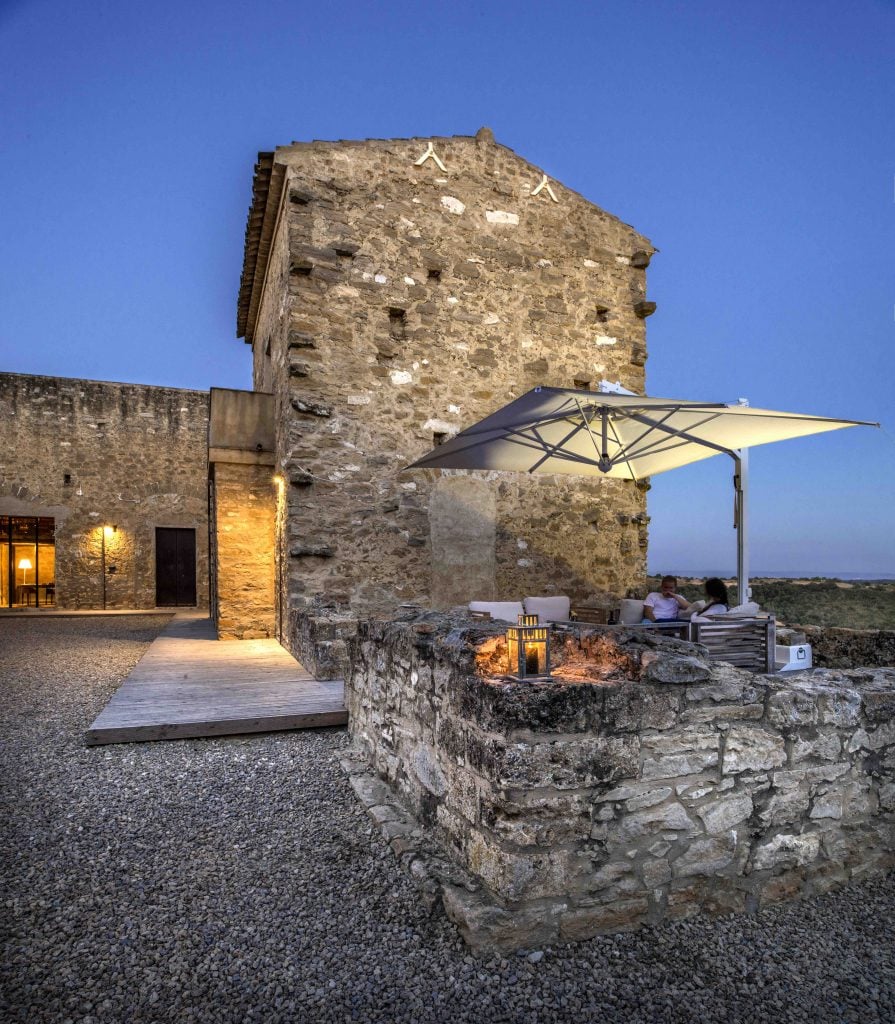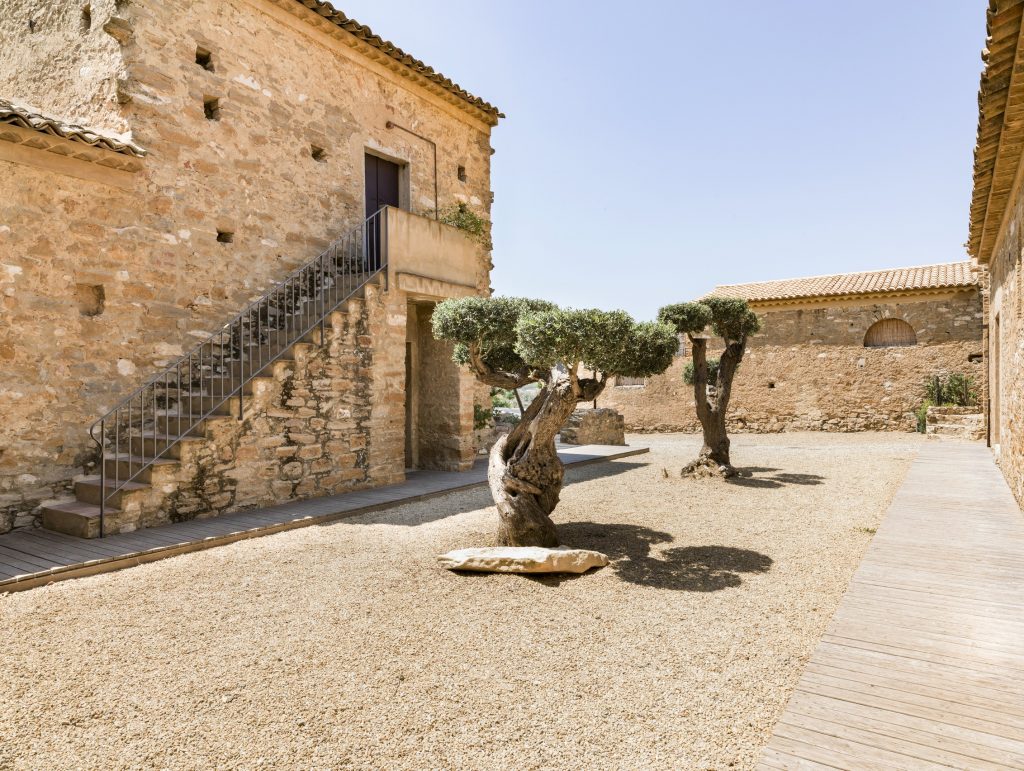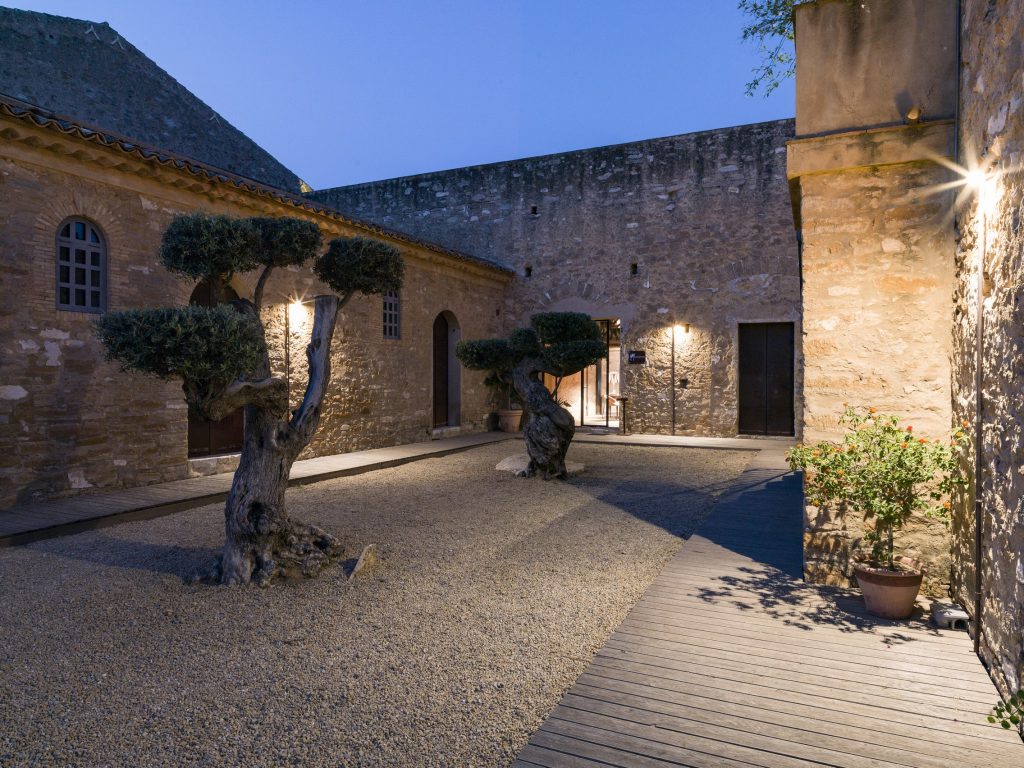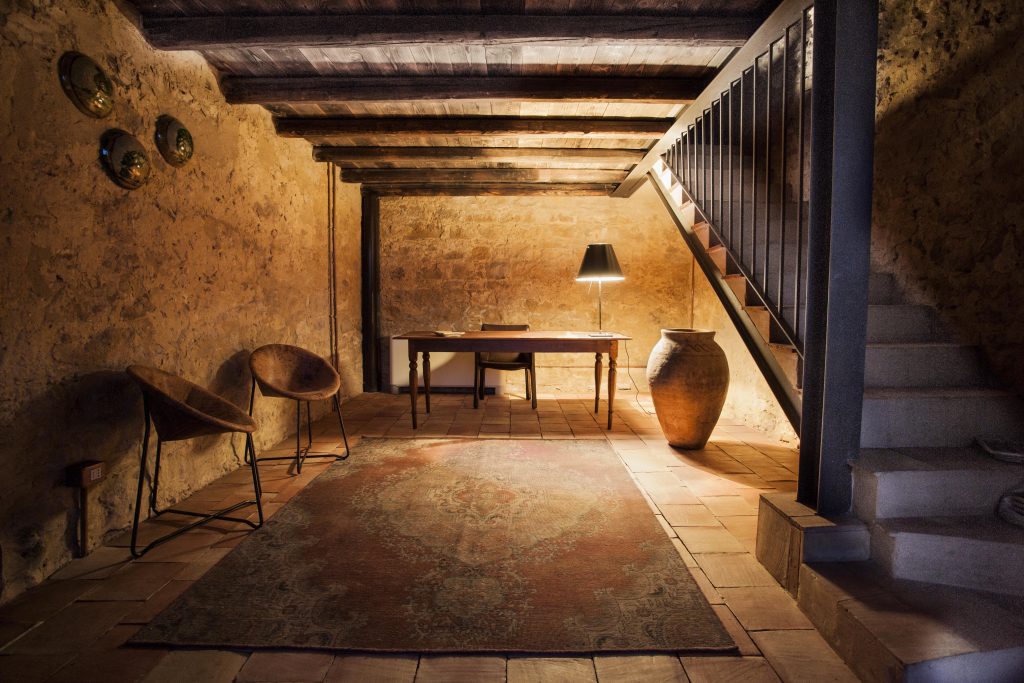Born in Siena in the year 1970, an excellent vintage, as he recalls with a smile, Alessandro Cellai calls himself “a Chianti”, as he grew up in Castellina in Chianti, in the very heart of Chianti Classico. The family was not involved either in viticulture or in wine but Cellai, as a child, had the good fortune to find a wine lover in the family, an uncle to be precise, both a wine lover and a priest whose country church had a vineyard. It was there that his passion for grapes and wine was born, and the next step, logically, was the oenological school of the city of Siena which, at that time, trained with a certain regularity the oenologists who have had a major role in the zone: Attilio Pagli, Claudio Gori, Paolo Caciorgna, Leonardo Bellaccini e and many others. Along with, as well, producers such as Giacomo Neri, Giuseppe Gorelli and Simone Santini.
The first professional experience came during the first half of the 1990’s, that of “technical director” of the Rocca delle Macie cellars, once again at Castellina in Chianti, where Cellai managed the vineyards and the production of grapes; the cellar work, instead, was in the hands of Gianni Gaspari from northern Italy’s Trentino region. A more prestigious position (and greater responsibilities) came in the middle of the decade when he became the director of Castellare di Castellina in the township where he grew up. There were some slight doubts and hesitations at the very beginning, given that he had to take charge of the entire operation, but the far-sighted reassurances of owner Paolo Panerai were to be prophetic: “a good professional winemaker can learn how to deal with administration and marketing, but an expert in these areas will never learn how to manage the vineyards and cellar of a producer”. The following two decades have demonstrated that Panerai’s words were right on the mark, and Cellai has not only taken over the Chianti Classico estate of Panerai but has also had a key role in the expansion into the Tuscan Maremma and into Sicily of what what has become “Domini Castellare”, the group of Panerai-controlled estates.
Q. Explain for a moment the steps which have taken your professional career far from where it began.
A. As we all know, Paolo Panerai is an entrepreneur endowed with the ability to clearly see how the future will develop, to move rapidly , and to arrive before the others. He had seen the important potential of the Maremma in the mid-1990’s and decided that the production of wine in central Tuscany had to be supplemented by a second type, completely different but unquestionably important, of the Maremma coastal area which was at the very beginning of the expansion we have witnessed. He involved as well – the project got off the ground in 1999 – his friend Eric Rothschild, a man of great importance in Bordeaux, and owner of nothing less than Château Lafite. Acccordingly, a joint venture, Rocca di Frasinello, was created at Gavorrano in the coastal province of Grosseto, 175 acres of vineyards and a futuristic cellar realized by famed architect Renzo Piano, the architect who designed the Pompidou Center in Paris as well as a friend of Paolo Panerai.
Q. What type of production was developed along the coast, a lower-lying and flatter zone which obviously was very different from the higher and hillier area between Florence and Siena?
A. the line consists of Bordeaux-style wines, duplicating the type of production which characterized our work at Castellina in Chianti would clearly have had no sense even if at Castellina we have always produced small quantities of Cabernet and Merlot. “Alternative” wines, offered to see how these grapes functioned in an environment far different from the Gironde, but very limited in terms of quantity, our main emphasis has always been on Sangiovese, and the various types and levels of Chianti Classico produced have never had French grapes in the blend, something we are very proud of. The experience with Bordeaux varieties, however, could only be useful when, in the Maremma, we had to meet the challenge of much larger-scale productions of Cabernet and Merlot, by now Tuscan classics as well. And which, from the very start, in our offerings, have been highly successful both in terms of image and of sales.
Q. And the decision to invest in Sicily?
A. In that case I can say, with much certitude, that we were leaders; aside from Gianni Zonin, another friend of Paolo Panerai, no non-Sicilian entrepreneur had thought of investing significant resources in a spot where, at the beginning of the new millennium, the largest part of the production was aimed at blending wines and bottled wine, apart from the area around Marsala, had little history and visibility outside of the island. Even if fine Sicilian cellars did exist and had begun that rise in their quality level which we have all witnessed. But, from those who arrived from outside of Sicily, the problems of confronting unknown zones and grape varieties represented, if not an insuperable obstacle, at least a factor which suggested caution and much reflection and pondering before taking the final step.
Q. The precise steps in the development of this new project?
A. We were already moving around the Island during the first years of the new millennium and we covered a lot of miles, searching for the right spot and the certitude in the choice among the many estates we looked at, there is no need to explain that investing in an area far away from where we had operated and little known to us was something far different from investing in another province of Tuscany, one which was not even very far from our home base of Siena. We found what we were searching for even if “found” is perhaps not the right word, in fact we fell in love with the property which became Feudi del Pisciotto, not merely the soil and the micro-climate but the structures we found in place, first and foremost the “palmenti”, the old cement tanks once used for treading grapes which seemed to embody a part of the island’s past, not only from an oenological point of view but also in socio-historical terms. The largest in all of Sicily, in fact.
Q. Can you give us a brief description of the new productive reality, the site and the terrain?.
A. We are located in the township of Niscemi in the province of Caltanissetta, the island’s southeastern corner, but we are in the northwestern angle of the province of Ragusa; Butera in the province of Caltanisetta, for example, another important viticultural site, is only fifteen miles away as the crow flies. Although we are in the southeastern part of Sicily, we are a mere four miles from the Mediterranean sea, a situation which guarantees much breeziness and, above all, highly useful temperature swings from daytime heat to evening and nighttime coolness, of much benefit as a brake to a too rapid ripening of the grapes. The soil, just as a large part of the province of Ragusa is, on the whole, sandy, but is also notably stony, principally gravelly, calcareous pebbles which add much structure and aroma to the wines. This richness in limestone, here just as elsewhere, is a positive factor in the development of fragrance and elegance in the wines. There are close to 115 acres of vineyards and we have planted an important range of grape varieties on the property.
Q. Indeed, the current trend is to emphasize native grape varieties, and Feudi del Pisciottto appears to be going a bit against the grain in terms of the latest market trends. Could this be a problem, either real or potential?
A. I frankly do not think so, first of all I do not believe in thinking in schematic terms which risk becoming Manichean, I do not see any reason according to which an estate cannot operate with an ample range of choices for its clientele, better “both …. and” than “either ….or”. We produce half a million bottles and Domini Castellare exports to sixty different markets or so, we cannot limit ourselves for commercial reasons as well even though the operation must be based on careful and in depth studies of the soil and micro-climate in order to single out the proper site for each and every individual variety.
I was greatly influenced by dr. Giacomo Tachis, a great oenologist who, we need to remember, gave a great impulse to the production of high level wine in Tuscany utilizing international grape varieties along with Sangiovese. His was a profound influence on me, on a personal level as well, and he was, for many years, the consultant to the island, working with the “Institute for the Vine and Wine”. He foresaw, even when few others did, a future of high quality wines of much personality. I inherited this as well, and have attempted to not only put his technical precepts into practice, important as they are, but also the spirit with which he operated, the conviction that serious work in the vineyards and cellars could unquestionably give highly gratifying results both commercially and in terms of the aromas and flavors of the wines to be offered.
Q. let’s talk first about the viticulture, there is a very ample range of grapes, how have they been distributed over the115 or so acres of vineyards currently producing grapes?
A. Given that, as I already explained, the soil is relatively homogeneous, the decisions about where to plan the different grape varieties were taken principally on the basis of the altitude of the individual vineyard plots. To describe this as concisely as possible: it is based on the date of the full ripening and the subsequent harvest. The two grapes for the regular white wine of the house, Inzolia and Catarratto, are in the lower part of the property, as are the Merlot and Cabernet, at 400 feet above sea level. The Frappato, Nero d’Avola, Syrah, and Grillo were planted a bit higher, in the middle of the hillsides, i.e. from 460 to 490 feet in altitude, and here I will add that this latter grape is cultivated at Menfi in the province of Agrigento in the only vineyard which is not part of the central vineyard block of the estate. The Viognier is somewhat higher, at 625 feet, while the early-maturing Chardonnay and Pinot Noir are situated at approximately 825 feet above sea level in order allow the greater coolness to slow down the ripening and harvest as late as possible. The choice of Pinot Nero might seem surprising, even eccentric, even if Dr. Tachis wished to experiment with this variety in Sicily, convinced as he was that the premises of well made wines were present, but at that moment in time the chosen spot was intended to be Mount Etna, where vineyards of over 2100-2300 feet above sea level were available. It was easy to be a bit skeptical about the potential of the province of Ragusa where, obviously, the soils and micro-climate are quite different from those of the volcano. But I have always loved this variety and its wines, exemplary in their fragrance and finesse, I cultivate it and ferment it at the small property I have at Castellina in Chianti, and I was not afraid of accepting the challenge of producing it here at Niscemi as well. The presence of calcareous stone in the sub-soil was encouraging, this grape has always given its maximum results in soils of this type. I must say that the results up until now are very positive indeed, the wine has been much praised both by the wine press and by our clientele, a demonstration that hard work and professionalism pay off in the end.
Q. organizing and managing so ample a range of grape varieties must be fairly complicated, how do you deal with it?
A. By now we are used to managing harvests of a certain complexity given that we have varieties which mature in different periods, and it is sufficient to properly control the ripening and be ready to move rapidly when it has reached the optimal ripeness levels for the type of wine we are seeking to produce. We had a great deal of practice in this type of work before arriving in Sicily, in the Maremma there is a substantial difference in the ripening period of Merlot and Cabernet, something which takes place everywhere these two varieties are cultivated. And even before, at Castellina, without considering the Chardonnay, even in the various vineyard parcels where Sangiovese is planted the maturation takes place at different times according to the altitude, the exposure, and the type of soil. We have consequently had to learn to move swiftly and punctually. The management of the picking has greatly changed since the initial part of the 1990’s when I began working as a professional, now there is much more attention to this critical moment and many studies and much research have focused in on the question of the proper maturity of the crop, of the definition of the moment when the analytical, or chemical, maturity of the grapes coincides with the true phenolic, or physiological, ripeness.
To be more specific: the picking at Niscemi normally begins with the Chardonnay and Pinot Noir and then continues with the Merlot and Cabernet towards the 15th to the 20th of August. The Cabernet and Syrah are harvested during the first week of September, the Grillo during the second week of the month, and the Nero d’Avola during the third week. The harvest finishes with the Frappato during the third and fourth week of September. As you can see, the harvest last from six to seven weeks, a lapse of time which allows us organize the logistical questions without excessive or exceptional pressure. The truly complicated harvests are those when it begins to rain when it’s time to pick, but this is a problem which we rarely have to confront on the island.
Q. Tell us something about the fermentation and aging since, in many cases, we are talking about new and very different grapes compared to those in Tuscany, both those in Chianti Classico and in the Maremma. Did they require new techniques compared to the varieties with which you had a certain familiarity.
A. In this case as well, things have greatly changed from the 1990’s when certain producers and winemakers pushed hard on the extractions and on the aging in oak with the aim of creating wines meant to impress with their power and intensity. We have never been interested in “show wines”, intended to amaze and astonish, and we have always practiced fermentations and aging aimed instead at creating wines which would join, in as harmonious a way as possible, structure and elegance. The fermentation of the red wines, accordingly, is classic both in terms of the temperatures and the length of the period of skin contact. The white wines, instead, are treated a bit differently in that, while controlling carefully fermentation temperatures, we take advantage of our cement tanks in order to avoid the electro-magnetic currents of stainless steel tanks which risk oxidizing the wines and creating problems for the aromas, the freshness, and the savor.
Q. Five hundred thousand bottles are not a small production, can you describe how you have organized the line in order to market it with greater intelligence and success?
A. in any wine-producing estate of a certain size (and often even in relatively small ones, around Alba for example, there are many small producers who offer both Dolcetto and Barbera in addition to Barolo or Barbaresco because they cannot ripen the more remunerative Nebbiolo everywhere on their property), the various vineyard plots give different results in terms of structure and character. We therefore have a line of regular wines which aim for varietal aromas and flavors and much drinking pleasure. This is a range, however, which is not lacking in flesh and consistence, and the wines all carry the name Baglio del Sole on their labels. In certain cases we manage to produce important numbers: 50 thousand bottles in the case of the Inzolia and Inzolia-Cataratto, 100 thousand bottles of Nero d’Avola and Merlot-Syrah. They are not aged in oak, but neither are they wines meant to be drunk young, there is definitely a certain structure and the Nero d’Avola is released after two years in the cellar, the Merlot-Syrah after three.
We then have our crus which are produced from our finest lots, and these wines, virtually without exception, are aged in small oak barrels. We have utilized them since the very start in the Maremma, and accordingly have a certain experience in their use, while in Chianti Classico we prefer puncheons, more than double the capacity of the classic Bordeaux barrique, gentler and more discreet in their impact on the wine, Sangiovese requires a lighter hand, it is a variety which gets along with oak but does not always love it, much care and judgment are necessary. We, however, have always taken it easy with oak, and in Sicily as well the percentage of new barrels is never more than 50%. First and foremost the territory and the variety, this has always been our philosophy even at a time when many producers sought to produce wines in which the impact of the sensations of oak from the barrels were very present indeed. Now that the market has turned its back on this type of wine we have been rewarded for the fidelity to the philosophy with which we have always operated. A note on another aspect of the this line of high level wines: the individual bottles carry the name of an important fashion stylist: there is the Valentino Merlot, the Versace Nero d’Avola, the Missoni Cabernet Sauvignon, the Gianfranco Ferré Gewürztraminer-Sémillon and so forth and so on. All the result of an agreement with the stylist, obviously, and a percentage of the profits from these wines are donated to the restoration of Sicilian works of art in order to give something back to the island for what it has given to us. The first works to become part of this program are the stuccoes of sculptor Giacomo Serpotta, among which is the work called “Eterno” which has given its name to our Pinot Noir as well. We are not Sicilians, but we have a debt of gratitude to the island, and this program, along with the work we have created with our investments, aims at paying off this debt on a continuous basis.
Q. How do you see the up-coming years now that you can judge the results of more than a dozen vintages, taste wines which, in the case of the better selections, now have a significant age, and evaluate both the potential of the estate and the way you have worked and the decisions taken.
A. I don’t want to say that I am satisfied because, in wine as in every professional field, it is always possible to do more and do better. But I think I can say, without the slightest hesitation, that the wines have repaid both the decision to invest in Sicily, to come to a spot which was very far and very different from our home base in Tuscany and our faith both in our own work and the new reality which we found. We travel a great deal in our work, for commercial reasons as well, but we normally move within the confines of a single sector, one which we know very well indeed. In the case of Feudi del Pisciotto, we encountered a spot which was radically different from the one we knew, very diverse both physically and culturally, and I must say that this encounter has enriched us both on a human level and from the technical-professional point of view. We travel, after all, in order to get to better know whom we aren’t as persons and what we don’t know, and from that point of view the advantages and rewards have been many and very important. If, instead, we wish to talk about the wines, there can be no doubt that, with the greater experience we have acquired and the greater age of the vineyards, a fine future awaiting us.
by Daniel Thomases
Feudi del Pisciotto
Niscemi (CL) – Sicily
winerelaisfeudidelpisciotto.com
- Il Wine Relais Feudi del Pisciotto
- archeologia del vino nel Wine Relais Feudi del Pisciotto
- Il Wine Relais Feudi del Pisciotto
- Il Wine Relais Feudi del Pisciotto
- Il Wine Relais Feudi del Pisciotto
- Il Wine Relais Feudi del Pisciotto




